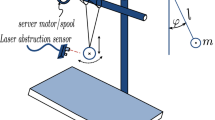Abstract
This note studies fully actuated linear systems in the frequency domain in terms of polynomial matrix description (PMD). For a controllable first-order linear state-space system model, by using the right coprime factorization of its transfer function matrix, under the condition that the denominator matrix in the right coprime factorization is column reduced, it is equivalently transformed into a fully actuated PMD model, whose time-domain expression is just a high-order fully actuated (HOFA) system model. This method is a supplement to the previous one in the time-domain, and reveals a connection between the controllability of the first-order linear state-space system model and the full-actuation of its PMD model. Both continuous-time and discrete-time linear systems are considered. Some numerical examples are worked out to illustrate the effectiveness of the proposed approaches.
Similar content being viewed by others
References
Duan G R, High-order system approaches: I. Full-actuation and parametric design, Acta Automatica Sinica, 2020, 46(7): 1333–1345 (in Chinese).
Duan G R, High-order fully actuated system approaches: Part I. Models and basic procedure, International Journal of System Sciences, 2021, 52(2): 422–435.
Duan G R, High-order fully actuated system approaches: Part II. Generalized strict-feedback systems, International Journal of System Sciences, 2021, 52(3): 437–454.
Duan G R, High-order fully actuated system approaches: Part X. Basics of discrete-time systems, International Journal of System Sciences, 2021, DOI: https://doi.org/10.1080/00207721.2021.1975848
Rosenbrock H H, State-Space and Multivariable Theory, Wiley Interscience Division, New York, 1970.
Kailath T, Linear Systems, Prentice-Hall, Englewood Cliffs, NJ, 1980.
Wolovich W A, Linear Multivariable Systems, Springer Science & Business Media, Berlin, 1974.
Zheng D Z, Linear Systems Theory, 2nd Edition, Tsinghua University Press, Beijing, 2002.
Alam R and Behera N, Linearizations for rational matrix functions and Rosenbrock system polynomials, SIAM Journal on Matrix Analysis and Applications, 2016, 37(1): 354–380.
Vologiannidis S, Antoniou E N, Karampetakis N P, et al., Polynomial matrix equivalences: System transformations and structural invariants, IMA Journal of Mathematical Control and Information, 2021, 38(1): 54–73.
Zaballa I, Feedback invariants of restrictions — A polynomial approach, Automatica, 2001, 37(2): 185–195.
Duan G R, High-order system approaches: II. Controllability and fully-actuation, Acta Automatica Sinica, 2020, 46(8): 1571–1581 (in Chinese).
Zhou B and Duan G R, An explicit solution to polynomial matrix right coprime factorization with application in eigenstructure assignment, Journal of Control Theory and Applications, 2006, 2: 147–154.
Author information
Authors and Affiliations
Corresponding authors
Additional information
This work was supported by the Science Center Program of the National Natural Science Foundation of China under Grant No. 62188101, the Major Program of National Natural Science Foundation of China under Grant Nos. 61690210 and 61690212, the National Natural Science Foundation of China under Grant No. 61333003, and the Self-Planned Task of State Key Laboratory of Robotics and System (HIT) under Grant No. SKLRS201716A.
Rights and permissions
About this article
Cite this article
Duan, GR., Zhou, B. Fully Actuated System Approach for Linear Systems Control: A Frequency-Domain Solution. J Syst Sci Complex 35, 2046–2061 (2022). https://doi.org/10.1007/s11424-022-1361-8
Received:
Revised:
Published:
Issue Date:
DOI: https://doi.org/10.1007/s11424-022-1361-8




